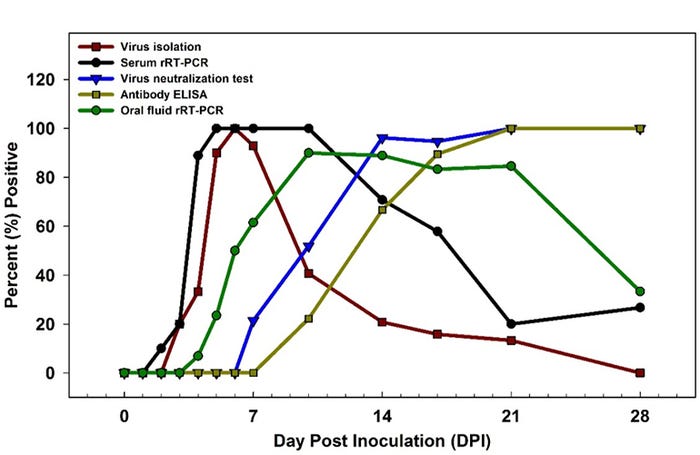Whether based on serum or oral fluid samples, effective CSFV detection will require a combination of virus- and antibody-based tests.
March 6, 2018

By Yaowalak Panyasing and Roongroje Thanawongnuwech, Chulalongkorn University, Bangkok Thailand; and Luis Giménez-Lirola and Jeff Zimmerman, Iowa State University
Classical swine fever or hog cholera was last diagnosed in the United States in a herd in Cape May, N.J., on Aug. 1, 1976 (USDA, 1981). Problem solved, right?
Actually, CSFV is globally widespread and continues to create havoc in many parts of Asia, Europe, Africa, the Caribbean, Central and South America. For this reason, the entry of CSFV into free areas is a continual risk, as illustrated by costly outbreaks in the Netherlands (1997‐98), United Kingdom (2000), Romania (2001), Slovakia (2001), Spain (2001), Germany (2006) and Russia (2015).
Early detection and rapid elimination
Fast recognition of infected animals is the key to effectively controlling incursions of a foreign animal disease. But early recognition of CSF on the basis of clinical signs is unlikely because current strains typically produce mild clinical signs that resemble porcine reproductive and respiratory syndrome, salmonellosis and a variety of other pathogens endemic to the U.S. herd.
This is why incursions of CSFV — even in parts of the world that are familiar with the disease — have routinely taken weeks, even months, to recognize. This prolonged “lag time” between the entry of CSFV into the United States and its detection will provide a generous opportunity for the virus to spread, given that approximately 1 million pigs cross state lines every day.
Can oral fluid samples be of use in foreign animal disease surveillance?
The use of oral fluid samples in the diagnosis and surveillance of swine diseases has become routine for pork producers and veterinarians in the United States and elsewhere. This practice is justified by an ever-growing body of research supporting the effectiveness of oral fluid samples for the detection of PRRSV, influenza A virus, porcine circovirus and a variety of viral and bacterial pathogens, including high-impact viral pathogens such as African swine fever virus and foot-and-mouth disease virus.
‘Now’ is the best time to prepare for CSFV
This is why the National Pork Board funded two collaborative projects between Chulalongkorn University in Bangkok, Thailand, and Iowa State University for the development of oral fluid-based CSFV diagnostics.
In their first project, Yaowalak Panyasing and colleagues evaluated the detection of CSFV in oral fluid and serum samples collected from individual CSFV-inoculated pigs over the course of 28 days. They used a variety of traditional and commercial assays designed to detect CSFV antibodies, antigen or nucleic acid as described elsewhere.
In brief, they found:
• CSFV infection was detected in oral fluids by rRT-PCR before the appearance of clinical signs, during the course of clinical signs and after recovery.
• However, a comparison of diagnostic assay performance showed that the optimal detection of CSFV infection required both nucleic acid (rRT-PCR) and antibody tests (Figure 1).
• Specifically, the data showed that the most effective detection of CSFV, especially the detection of low virulence strains, will require the use of rRT-PCR-based assays for the detection of early infections (less than 14 days) and antibody-based assays, thereafter.

Figure 1: Responses over time (DPIs 0 to 28) for selected virus and antibody detection assays for CSFV inoculated groups. Real time reverse transcription polymerase chain reaction (rRT-PCR): LSI VetMax CSFV (PPC), Life Technologies, Le Bois Dieu, Lissieu, France; Antibody enzyme-linked immunosorbent assays (Antibody ELISA) PrioCHEK CSFV Antibody 2.0 ELISA, Prionics Lelystad, Lelystad, Netherlands. Panyasing et al. Vet Microbiol 216 (2018) 72–78
In their second project, Panyasing and her team are investigating CSFV antibody responses in oral fluid samples. Similar to their previous work on PRRSV and influenza A virus antibodies in oral fluids, their preliminary results show that CSFV antibodies are readily detected in oral fluids and mirror the antibody response in serum.
Implications/conclusions
Research and practice have shown that oral fluid-based diagnostics for CSFV are both technically possible and could be one part of the rapid response that we need to have in hand for CSFV. But whether based on serum or oral fluid samples, effective CSFV detection will require a combination of virus- and antibody-based tests.
Furthermore, although there is much work yet to be done, preliminary data suggest the possibility of oral fluid antibody assays capable of differentiating infected from vaccinated animals using marker vaccines.
You May Also Like


